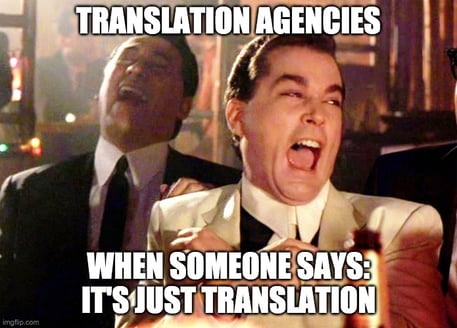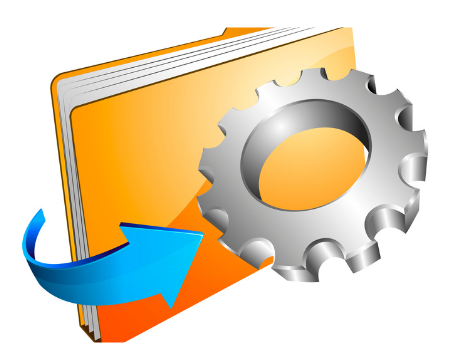%20(1)%20(1).png?width=740&name=Speed%20up%20business%20growth%20through%20translation%20(1)%20(1)%20(1).png) Warren Buffett was right! To some extent.
Warren Buffett was right! To some extent.
He once said that no matter how great the talent or efforts, some things just take time. You can't produce a baby in one month by getting nine women pregnant. It's not always that simple.
But, how about translating your content into 9 languages at once? The business world will not wait for you to produce and translate your content. You have to do it fast.
Is it possible at all?
Yes, it is. You can translate your content into multiple languages at once in a fast and cost-efficient way. You just have to know how.
At ATL, we have worked with many international clients who wanted to have their content translated into more than one language at once. This article will present aspects that will help you speed up your content translation into multiple languages.
Without the full understanding of how the translation agencies work and what is involved in the translation process, your translation into multiple languages at once may be delayed. And Warren Buffett's words may become a prophecy of some sort. No matter the talent, without proper understanding of the process and what's required for it to go smoothly, translation into multiple languages at once will take a lot of time.
Related content: How to Reduce Turnaround Time for Content Translation

Project management and people operations play a great role in translation process. Translation capacity is more or less 2,000 words per work day. However, in order to successfully prepare the content or the product for a local market, what is needed is way more than just translation.
Let's see how long it takes to finish a multilingual project, and what can be done to speed up the process.
A hypothetical situation: A localization company is going to work on a translation from English into Spanish, French, Chinese, Japanese, Italian, Portuguese, Russian, Arabic and Korean. There are 9 languages included in the project estimate. In order to estimate the cost of the project they do not need nine project managers.
This process is almost completely automated, and the localization project manager only monitors the operations to make sure that the right data is taken into account. The number of words in the source document is the same, regardless of the language pair in this project.
A TMS (Translation Management System) quickly applies the rates for particular language pairs and the translation proposal can be easily made for all 9 languages at the same time.
Another scenario would be working on a continuation of a project - an update. All the previously translated words are stored in the database called TM (Translation&Memory).
The translation project manager searches particular translation memories and analyzes the new content for translation against the already translated segments (portions of a text, for example a sentence). The analysis shows how many words need translation from scratch, how many words are placed in segments that have 50% equivalents, or an even higher match percentage. There may also be segments that will just require revision.
Related content: Translation Memory Analysis in Practice
As a consequence, the same number of pages in a document, may take just half of the time to be translated. The amount of time needed for translation may be different for different languages. It mostly depends on the amount of text previously translated and stored in the TM.

Preparing content for translation is another time-consuming step in the translation process. It takes place within the source files (the original text files), and it includes internationalization, engineering, DTP, file preparation, and more.
It does not matter how many languages the files are going to be translated into. When we talk about preparing the content for translation, the source files need to be prepared only once and can be used for translation into all nine languages.
Sometimes the files need technical preparation. But sometimes they need to undergo the internationalization process. Internationalization is the act of preparing the product or content for localization. All the localization obstacles need to be removed from the files.
Related content: 6 Tips on Preparing Your Content for Translation
With regard to software translation, Unicode needs to be used. For websites and graphics - more space needs to be taken into account. When it comes to documentation localization, one example of localization obstacles may be the writing direction.
Right to left writing has to be supported for Arabic language as well as the local diacritics for Spanish or French. Other file preparations concentrate on file formatting. For example, no hard breaks are allowed. Hard breaks, also called hard returns, are created in text editors by pressing Enter or Return on your keyboard.
When the file is ready and meets the internationalization and formatting requirements, it needs to be divided into logical chunks, called segments. This is done by translation software when a bilingual .xliff file (XML Localization Interchange File Format) is being created.
When the source file is prepared and properly segmented, the CAT (Computer Assisted Translation) toolturns the source files into bilingual files. One file for each of the separate language pairs. The bilingual files are created in order to use the advantages of translation memory.
Related content: File Formats vs. Technical Translation Turnaround Time: What's the Catch
The TM (Translation Memory) is a database containing all the translated segments in the original language as well as the corresponding, approved translations. If the hard breaks are used in the middle of a sentence, the sentence will be cut into two segments.
One of the differences in various languages is the structure of a sentence. Verbs can be used at the beginning or at the end of a sentence. All these differences can lead to a situation where half of the sentence is saved in the TM with a half of the translation. This results in incorrectly translated segments, and in consequence, this will reduce the TM savings in the future.
Related content: A Guide to Understanding Translation and Localization Terminology
Translation Memory is also very important for consistency reasons. Consistency is the key factor while working with a group of linguists on the same text. The teams are set up and managed by localization project managers.
It is possible for more than one translator to translate different parts of the same project with no harm to quality and consistency. Properly managed workflow, and carefully organized resources are the key to success.
In order to maintain consistent style and terminology, a shared online TM is used. The shared TM is updated on a real-time basis as soon as one of the linguists approves the segment.
Such workflow needs to be properly managed. An experienced localization project manager will know how to guide the team in order to avoid introducing inconsistencies.

There are linguists who like to translate the text and review it after the whole piece of work is done. This is not possible when working on shared content.
In this case, the segments saved to the TM need to be the final translations, not drafts. One also needs to confirm the translated segments as soon as possible. It is crucial to confirm the ready translations since they are immediately stored in the shared TM.
The CAT tools helps to streamline the process by pointing out inconsistencies in translations. Whenever one linguist uses translation that is inconsistent, the tool reports possible error and warns the linguist. The project manager is also informed about this possible issue and can react immediately.
When the files are ready for translation, the next step is file distribution. Reference material, in most cases, needs to be created only once, no matter how many languages are included in the project. All the instructions concerning the tone of voice and the context are provided, despite the number of language pairs.
Basic questions concerning currency conversion or metrics are also not based on the number of languages in the project. Therefore, the general instructions are created once and shared with the whole team, no matter what the native language of the linguist is.
What differs, and needs to be prepared separately, is the language-specific instructions. A separate Translation Style Guide needs to be created for particular languages. A translation Style Guide includes rules about writing style, voice, sentence structure, and spelling, but it is not a grammar manual for that language. It helps to choose the approved version of all correct available equivalents.
It contains information about your preferences with regard to tone of voice as well as furnishing written instructions appropriate for the target audience. A properly prepared Translation Style Guide in addition to detailed project instructions helps avoid linguistic queries and maintain consistency. Professional and experienced translation companies will work on it with you.
Another time-consuming step in the project flow is terminology translation. The terminology is extracted from the original file. It doesn't matter if you translate into Spanish, French, or Japanese. The same terms will need to be translated into all the languages of our localization project. First, the source text needs to be closely examined by the terminologist. The suggested terms will be extracted and translated.
Most of the modern CAT tools contain terminology extraction modules. They help scan the text for vocabulary and the terminologist, a professional linguist who is an expert in the subject area, can then decide which terms will be added to the terminology list.
What happens next is that the linguists, native speakers of a particular language and experts in the subject area, work on the list of terms and suggest possible translations. These translations are then approved by client reviewers. The approved terms will be used consistently throughout the translation project.
The list of terms will also be incorporated into the QA (quality assurance) module in the CAT tool. Every time a translator introduces an inconsistent translation, the translation tool flags an error.
%20(1).png?width=555&name=images%20for%20translation%20(1)%20(1).png)
Another kind of reference material that is created only once, despite the number of localization languages, is visual references. Any photos or images of the product that can help linguists grasp the context are collected once, no matter how many languages are included in the project.
A properly managed localization project will also share all linguist questions and client answers. This information should always be available for all the members of the team.
It does not matter if the team member is working on French or Japanese, a question regarding context needs to be visible, together with its answers, for the whole localization team. The same rules apply to any other queries unrelated to language.
One of the tricks used by localization professionals to speed up your time- is integration of their translation software with your system. Integrations allow the content to be shared with the translation providers immediately, without any back and forth. No folder arrangements, no renaming, no version monitoring. The files never leave the system, it is the data that migrates.
Related content: A Lack of Translation Integration With Your System: Trouble Alert
The content is uploaded immediately after the translation agency finalizes it on their side. You do not need to download, unzip, and upload separate packages. In just a click, the data find its way back to you. The systems communicate with each other and neither you, nor the localization manager, need to mark the files with language codes.
When the systems are integrated with the translation tools, the carefully selected translation teams are waiting for the content to be released for translation. Even if the workflow seems to be fully automated, there are experts behind the scenes. They set up the whole integration and the workflow especially for you.
Therefore, it is true that some projects may be delivered faster, but it needs to be done with the application of proper risk management techniques.

It may happen, that somebody will try to cut corners and will remove project management from the translation process.
But what if, in one of the translated documents, the name of your product is translated and in others it stays in English? This, and many other potential issues that may come up, calls for localization project management.
The steps that will consume a lot of the estimated time are translation and revision. Translation needs to be conducted separately for all nine language. However, this step can also be accelerated.
A few years ago, the revision step used to be conducted only after the whole document was translated and sent to a reviser.
Now it's more flexible and fast:
.png?width=475&name=speed%20up%20translation%20(1).png)
It may sound like translating into many languages could take a long time.
When you cooperate with a professional translation agency, the localization of all the languages included in the project, will take place at the same time thanks to various solutions that they offer:
All these solutions and more, will speed up your content translation, regardless of the number of languages you choose. The right translation partner will not only ensure the fast turnaround time for your content localization, but they will also see to it that you save on translation instead of overspending on it.
Recommended articles:
+1 857 777 5741 ext. 203 (business inquiries)
+1 857 777 5741 ext. 205 (career inquiries)
Trylinskiego 16, 10-683
Olsztyn, Poland
Copyright ATL 2025. All Rights Reserved.